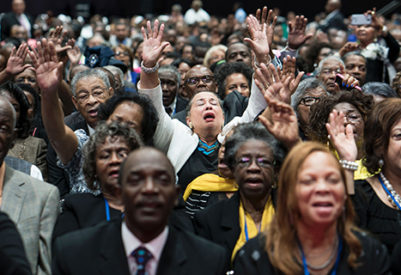
Southwest Tribune Newspaper
In the United States, Black-white disparities in maternal mortality—deaths related to pregnancy or childbirth—may be larger than previously reported, new research shows.,” According to the Population Reference Bureau (PRB). Closing the gap involves addressing structural racism—that is, those aspects of social, political, economic, and health care systems that reinforce inequity, researchers say.”
Because pregnancy is riskier to women’s health than abortion, state initiatives to restrict abortion could lead to more deaths, particularly among Black women, new estimates suggest.
By thoroughly reexamining death certificates from 2016 and 2017, researchers found that the maternal mortality rate among non-Hispanic Black women was 3.5 times that of non-Hispanic white women. This is a dramatic increase from previous analyses, based on standard medical codes, that found that Black women faced a maternal death rate 2.5 times that of white women, according to Marian MacDorman of the Maryland Population Research Center (MPRC) at the University of Maryland, who led the study.
The new analysis also revealed that these disparities were concentrated among a few causes of death. Postpartum cardiomyopathy (a form of heart failure) and the blood pressure disorders preeclampsia and eclampsia were leading causes of maternal death for Black women, with mortality rates five times those of white women. Pregnant and postpartum Black women were also more than two times more likely than white women to die of hemorrhage (severe bleeding) or embolism (blood vessel blockage).
In the researchers’ analysis, embolism and preeclampsia/eclampsia tied for the leading cause of maternal death across all racial and ethnic groups during pregnancy or within six weeks after pregnancy (see figure). These were followed by postpartum cardiomyopathy, hemorrhage, and complications from obstetric surgeries such as cesarean sections.
Among White and Hispanic women, causes of maternal death ranked somewhat similarly. However, for Black women, preeclampsia/eclampsia was the leading cause of maternal death, followed by postpartum cardiomyopathy, embolism, and hemorrhage. Ectopic pregnancy, the fifth leading cause of maternal death for Black women, was not a leading cause for white or Hispanic women.
The study also found that late maternal deaths—those occurring between six weeks and one year postpartum—were 3.5 times more likely among Black women than white women. Postpartum cardiomyopathy was the leading cause of late maternal death among all races, with Black women having a six-times-higher risk than white women.
The prominence of cardiovascular conditions—eclampsia, preeclampsia, embolism, and cardiomyopathy—among the leading causes of maternal death, particularly for Black women, “highlights the importance of increased vigilance to improve early diagnosis and treatment of these complications,” MacDorman says.
The elevated risk of maternal mortality for Black women, from multiple causes, reflects the impact of structural racism on health and health care in the United States, argues study coauthor Marie Thoma of the University of Maryland School of Public Health and the MPRC.
“Further research into the experiences of people of color can inform efforts to improve health care systems and, thus, improve the birthing experience for all,” Thoma says. “We need new models of care before, during, and after birth to address these inequities.”
Addressing the stark racial disparities that MacDorman’s team highlighted requires fundamentally reorienting the current approach to health care, argues Rachel Hardeman of the Minnesota Population Center at the University of Minnesota. Research and action must be grounded in the understanding that racism is at the root of health inequities, she says.
“We must first ask, ‘How do systems, policies, and social structures combine to create the conditions for poor health?’ rather than asking, “’What’s wrong with people of color that makes them die younger and at higher rates and suffer more illnesses?’’” says Hardeman, who is also director of the new Center for Antiracism Research for Health Equity at the University of Minnesota.
As part of a four-person team, Hardeman documented that Black newborns’ in-hospital death rate was one-third lower when Black newborns were cared for by Black physicians rather than white physicians.
Hardeman is now studying a model prenatal care program designed to reduce birth complications and maternal death that “treats a mother’s culture, racial identity, and background as assets during pregnancy, rather than pathology or a problem.”3 The Roots Community Birth Center is an African American-owned; midwife-led, freestanding birth center located in a Minneapolis neighborhood with one of the highest infant mortality rates in the city.
The care plan includes regular prenatal classes on gestational diabetes, nutrition, and other topics, and longer and more frequent-than-typical prenatal and postnatal visits, including three home visits in the first week after birth.
Since opening in 2015, the birth center has cared for 284 families with no premature or low-birth weight babies and a high proportion of mothers successfully breastfeeding. Preliminary findings suggest this model shows promise for providing midwifery care in a culturally centered environment, according to Hardeman.
However, the birth center faces financial challenges due to current maternity care payment models and inadequate Medicaid reimbursement, Hardeman says. To support innovative centers such as Roots, Hardeman suggests policymakers increase Medicaid reimbursement rates. In the long run, the added expense will lead to increasing numbers of healthy babies and mothers who avoid expensive and dangerous complications, and—ultimately—reduce racial disparities, she says.
Legislation designed to limit abortion could exacerbate racial disparities in women’s health and survival. New research by Amanda Stevenson of the CU Population Center at the University of Colorado Boulder shows that banning abortion nationwide would lead to a 21% increase in the number of pregnancy-related deaths for all women and a 33% increase among Black women, compared with rates for 2017.
Published in the journal Demography, the study estimates only the portion of increased deaths from such a ban due to complications of being pregnant and delivering a baby. Any increases due to unsafe abortions or attempted abortions would be in addition to these estimates.
“The takeaway here is that if you deny people abortion, pregnancy-related deaths will increase because staying pregnant is more dangerous than having a safe, legal abortion,” Stevenson says.
Stevenson points out that media outlets and some supporters of abortion rights often raise the specter of dangerous “back alley” or self-induced abortions. But deaths from such incidents, which numbered in the hundreds annually prior to the 1973 Roe v. Wade decision, would be far less common today due to the advent of safe, self-managed abortions using medications, including misoprostol, available via prescription or online, Stevenson reports.
“We expect a lot of people will turn to these safer forms of self-managed abortions, but a lot of people will also just stay pregnant,” Stevenson says. “What happens then?”
Carrying a pregnancy to term is many times riskier than having an abortion—14 times riskier, according to one estimate.
To predict the maternal mortality consequences of stricter abortion laws, Stevenson used published statistics on the number of abortions and births that occurred annually in recent years, calculated how many more pregnancies would be continued in the absence of legal abortion, then applied pregnancy-related mortality statistics to that number.
The study estimated that in the years following a national abortion ban, an additional 140 women would die annually from pregnancy-related causes, representing a 21% increase from 2017. Among non-Hispanic Black women, pregnancy-related deaths would increase by one-third.
Among white women, the lifetime risk of pregnancy-related death following a national ban would increase from 1 in 4,500 to 1 in 3,900, Stevenson found. By contrast, among Black women the lifetime risk of pregnancy-related death would increase from 1 in 1,300 to 1 in 1,000.
Research also shows that those most likely to seek abortion care, including Black and Hispanic women, women with lower income, and those with chronic or acute health conditions, are also more likely to encounter serious complications during pregnancy, Stevenson explains.
Black women are more likely to seek an abortion for a variety of reasons, including unequal access to housing, education, jobs, and health care, Stevenson says. Meanwhile, the mortality risk of carrying a pregnancy to term is more than three times higher for non-Hispanic Black women compared with non-Hispanic white women.
“Increasing Black women’s exposure to the risk of pregnancy-related mortality by denying them access to abortion would exacerbate an existing public health crisis,” Stevenson says.





